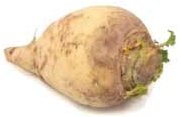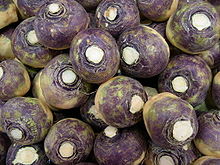- For the Drosophila gene, see Rutabaga (gene).
| Swede, (Yellow) turnip, Rutabaga | |
|---|---|

| |
| Scientific classification | |
| Kingdom: | |
| (unranked): | |
| (unranked): | |
| (unranked): | |
| Order: | |
| Family: | |
| Genus: | |
| Species: | B. napobrassica
|
| Binomial name | |
| Brassica napobrassica | |
The rutabaga, swede (from Swedish turnip), or yellow turnip (Brassica napobrassica, or Brassica napus var. napobrassica) is a root vegetable that originated as a cross between the cabbage and the turnip. Its leaves can also be eaten as a leaf vegetable.
Etymology
"Swede" is the preferred term used in much of England, Wales, Australia, New Zealand and India, while "rutabaga" (from dialectal Swedish rotabagge, literally, "root ram") is the common American and Canadian term for the plant. In the U.S., the plant is also known as "Swedish turnip," "yellow turnip", or "wax turnip", (as it is sometimes sold with a waxy coating to preserve freshness) while in Ireland, where turnips are relatively unknown, it is referred to as a turnip. The name turnip is also used in parts of Yorkshire. In Atlantic Canada they are referred to as turnips. In Scots, it is either "tumshie" or "neep",[1] and the turnip (Brassica rapa var. rapa) instead is called a "white turnip". Scots will refer to both types by the generic term "neep" (from Old English næp, Latin napus).[1][2] Some will also refer to both types as just "turnip" (the word is also derived from næp).[2] In North-East England, turnips and swedes are colloquially called "snaggers". They should not be confused with the large beet known as a mangelwurzel. Its common name in Sweden is kålrot (literally "cabbage root").
Halloween
Prior to pumpkins being readily available in the UK and Ireland (a relatively recent development), swedes were hollowed out and carved with faces to make lanterns for Halloween. Often called "jack o'lanterns", or "tumshie lanterns" in Scotland, they were the ancient symbol of a damned soul.
History

Swede was an important nutritional source for many Finno-Ugric tribes before the introduction of potatoes. Some claim the vegetable is native to Sweden, but others think it was introduced to Sweden, possibly from Finland or Siberia, in the early 17th century.[citation needed] From Sweden, it reached Scotland, and from there it spread to the rest of Great Britain and to North America.
In continental Europe, it acquired a bad reputation during World War I, when it became a food of last resort. In the German Steckrübenwinter (rutabaga winter) of 1916–17, large parts of the population were kept alive on a diet consisting of swedes and little else, after grain and potato crop failures had combined with wartime effects. After the war, most people were so tired of swedes that they came to be considered "famine food," and they have retained this reputation to the present day.[citation needed] As a consequence, they are rarely planted in Germany.[citation needed]
Preparation
Finns cook swede in a variety of ways; roasted to be served with meat dishes, as the major ingredient in the ever popular Christmas dish Swede casserol ("lanttulaatikko"), as a major flavor enhancer in soups, uncooked and thinly julienned as a side dish or in a salad, baked, or boiled. Finns use swede in most dishes that call for any root vegetable.
Swedes and Norwegians cook swede with potatoes and carrots and mash them with butter and cream or milk to create a puree called "rotmos" (root mash) and "kålrot/kålrabistappe" in Swedish and Norwegian, respectively. Onion is occasionally added. In Norway, kålrabistappe is an obligatory accompaniment to many festive dishes, including smalahove, pinnekjøtt, raspeball and salted herring. In Wales, a similar dish produced using just potatoes and swede is known as "potch".
In Scotland, swede and potatoes are boiled and mashed separately to produce "tatties and neeps" ("tatties" being the Scots word for potatoes), traditionally served with the Scottish national dish of haggis as the main course of a Burns supper. Neeps may also be mashed with potatoes to make clapshot. Regional variations include the addition of onions to clapshot in Orkney. Neeps are also extensively used in soups and stews. In Yorkshire and Lincolnshire, swedes are often mashed together with carrots as part of the traditional Sunday roast.
In Canada swedes are used as filler in foods such as mincemeat and Christmas cake, or as a side dish with Sunday dinner in Atlantic Canada. In the US, swedes are mostly eaten as part of stews or casseroles, served mashed with carrots, or baked in a pasty.
Other
The town of Cumberland, Wisconsin, U.S., celebrates a "Rutabaga Festival" annually, always the weekend preceding Labor Day Weekend. The International Rutabaga Curling Championship annually takes place at the Ithaca, New York, farmer's market.[citation needed]
Excessive consumption of swede can be associated with hypothyroidism. Swede and other cyanoglucoside-containing foods (including cassava, maize, bamboo shoots, sweet potatoes, and lima beans) release cyanide, which is subsequently detoxified into thiocyanate. Thiocyanate inhibits thyroid iodide transport and, at high doses, competes with iodide in the organification process within thyroid tissue. Goitres may develop when there is a dietary imbalance of thiocyanate-containing food in excess of iodine consumption.[citation needed]
In Southland - New Zealand, larger and tastier Swedes are quite common due to the more appropriate climate.[3] On average they can go around a few kilograms in weight compared to the much smaller ones grown in the North Island where there they are inclined to get drier or uneven weather patterns and do not have the common winter frosts to mature.
Frank Zappa, in the song "Call Any Vegetable", from the album Mothermania, sang the name of the rutabaga, in the form of a slow yodel.
See also
References
- Delange F, Iteke FB, Ermans AM. Nutritional factors involved in the goitrogenic action of cassava. Ottawa: International Development Research Centre, 1982.
- Braverman LE, Utiger RD. Werner and Ingbar's The Thyroid: A Fundamental and Clinical Text, 6th Edition 1991. J.B. Lippincott Company, Philadelphia, Pennsylvania, pg 371-2.